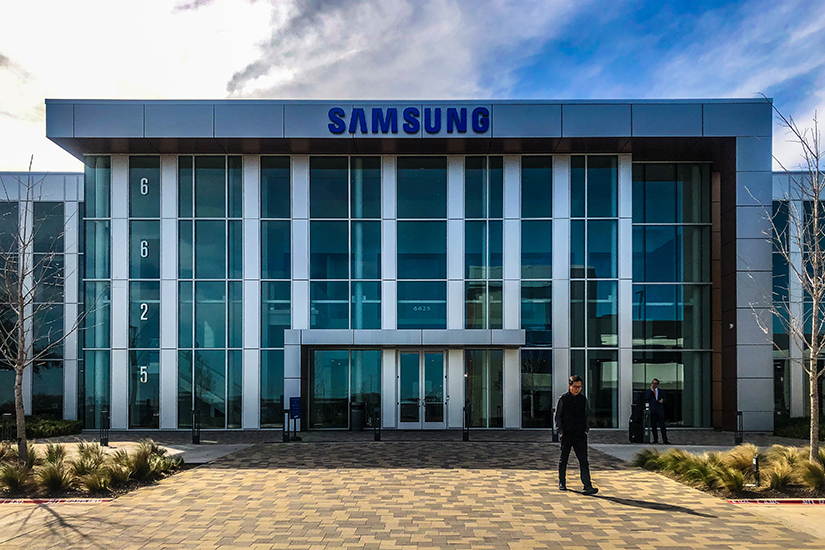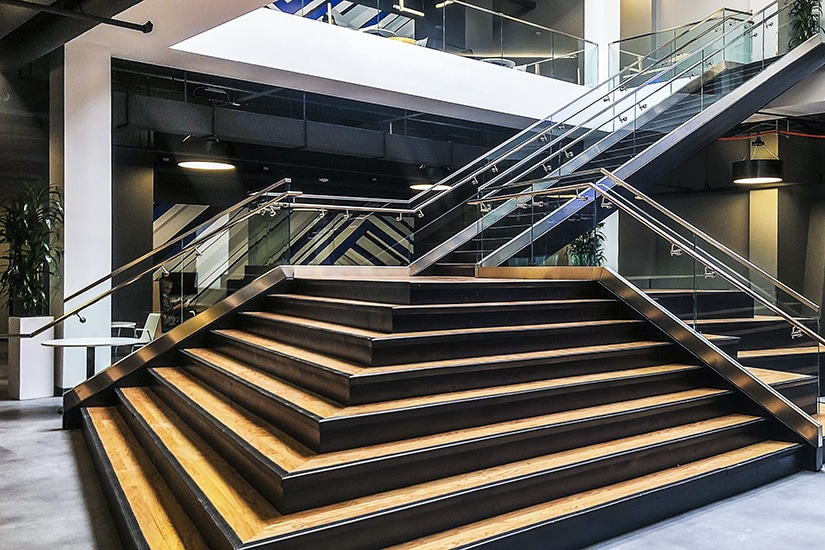|
Getting your Trinity Audio player ready...
|
As Samsung delivers its products to consumers and business people on the go, the world’s largest manufacturer of smartphones is also encouraging its employees to work untethered from their desks. The multinational tech giant revamped its office design to take full advantage of its innovations, resulting in a radically upgraded workplace environment at the new campus in the greater Dallas area.
“When you make people proud of the space where they work, they will likely excel at what they do,” says Alejandro Rivero, director of corporate real estate at Samsung Electronics America. “A space that inspires creativity and fosters collaboration results in employees being motivated to perform.”
The 215,000-square-foot office in Plano, Texas, adopted an open-style concept with generous amenities. Though the new location provides enviable features including a modern fitness center, lap pool, fire pits, and walking trails on the campus, the project was guided by some practical considerations. Samsung’s office space consolidates Dallas operations from multiple sites to one, which will spur better internal communication and teamwork, and is more economical, according to Rivero.

Rivero was involved with the project from conception and he partnered with other teams to bring it to completion. The effort required a collaborative programming, design, and change management program involving more than 20 business groups and a concerted effort to get executive buy-in.
“Connectivity is at the heart of Samsung’s future in North America,” says Justin Denison, senior vice president and general manager at Samsung Electronics America. “In order to achieve this, openness, collaboration, and inclusivity must be incorporated into our workplace and everything we do in Texas and around the world.”
Samsung’s previous Dallas-area sites in suburban Richardson and Plano had more than a thousand employees in multiple buildings. The company will continue to operate out of its facility in Coppell, Texas, which serves as a product warehouse.
The lease in the Richardson location, which housed a majority of the employees, was set to expire in 2019. As such, in 2017, Rivero and other decision-makers began investigating a change of venue. They wanted a site that could unite the workforce in one space. The company envisioned a brand-new environment that would make it easy for employees to move from space to space during the day. And, importantly, it would have impressive amenities to attract and retain top talent.
A new mixed-use redevelopment of a former Texas Instruments office park in neighboring Plano checked those boxes. When completed, Legacy Central would have a fitness center, attractive outdoor space, state-of-the-art conference center, and a high-end food hall close to a 215,000 square-foot building that could be renovated according to Samsung’s specifications. After a commuting pattern study to ensure that employees would not be greatly inconvenienced by the move, Legacy Central rose to the top of the relocation short list.
Developers of the 85-acre development already had a vision in sync with Samsung’s plan for upgraded amenities. The fitness center boasts a full-length indoor basketball court, rock climbing wall, and adjacent pool, along with more typical features such as fully outfitted cardio and weight training equipment in addition to yoga rooms. As the first large commercial tenant, Samsung could lease a building next to this prized feature.

The two-story office building’s interior design revolves around a centrally located foyer encompassing a sweeping staircase. Bathed in natural light from a large skylight, employees can grab a cup of coffee and food items in this area. The office hub is intended to foster impromptu conversations that build camaraderie and spur innovative ideas. “We didn’t have an area like this in the old space,” Rivero says. The new social hub and all of the amenities within the development have upgraded the workplace experience, achieving a key objective.
“The new facility at Legacy Central allows Samsung to remain close to its roots in North Texas while occupying modern office space tailored to the needs of the company and its employees,” adds Matt Astrachan, vice chairman of brokerage services at JLL, which helped negotiate the office lease. “The move gives the firm room to grow in a high-tech complex with the ability to provide a robust complement of amenities to retain and recruit employees.”
Visitors may take note of one missing element: no traditional desk phones. Instead, all employees are fully mobile with the ability to work anywhere in the building or outside in the many seating areas served by Wi-Fi. Every nook is in reach of Samsung’s wireless access points, controllers, and switches that power mobile voice and data service. The Legacy Central office is now a showcase for the company’s wireless products, including mobile devices, audio/visual products, and digital flip charts. “We are living the innovation that we are creating,” Rivero says.
The lobby and main hallway tout the Samsung brand. Visitors are greeted by a large digital display that might offer them a welcoming message. The corridor leading from the front door to the central hub contains displays, marketing exhibits, and video screens highlighting Samsung products.
Design of the main workspace area is a sharp departure from the old office. There are few individual offices—even senior vice presidents work in open spaces. There are many more meeting and collaboration rooms of various sizes, though. Many of these spaces are walled off by glass to allow natural light to penetrate the interior and visually connect people. “We made it a point to provide employees with choices about where and how to work,” Rivero emphasizes. “We want people to feel that the entire building is their office.”
Moving from a traditional office scheme to a modern, open-office concept presents a significant cultural shift. With that in mind, the general affairs team led a comprehensive change management program that included regular touch points with a group of “change agents,” ongoing communications with employees, and interactive sessions. They held an open house to inform employees and get feedback several months prior to the move. The event included demonstrations of the new office furniture, including adjustable height desks that can be used for standing or sitting.
Getting executive buy-in for an office transformation is always critical, Rivero says. Top executives, who frequently visit technology customers and partners in Silicon Valley, wanted Samsung’s new office design to reflect the values and culture of the company and not to look like a generic tech company. “They wanted something like this to happen,” Rivero says. “They appreciated that we came to them with a concrete vision.”
Though Samsung executives strongly supported the design concept and amenity upgrades, they also were motivated by old-fashioned business values. The consolidation of operations to one building allowed Samsung to mitigate rent increases. So, it’s a big upgrade for no additional cost.
The 1,300 employees that moved into the new space this February can now take full advantage of the new fitness, food, and diverse workspace options. In this new space, Samsung’s workforce is more prepared than ever to continue bringing innovative ideas to the masses.


